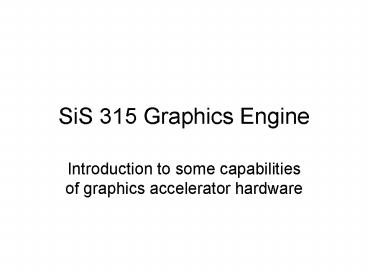SiS 315 Graphics Engine - PowerPoint PPT Presentation
Title:
SiS 315 Graphics Engine
Description:
SiS 315 Graphics Engine. Introduction to some capabilities of graphics accelerator hardware ... registers must be initialized beforehand, to enable engine ... – PowerPoint PPT presentation
Number of Views:69
Avg rating:3.0/5.0
Title: SiS 315 Graphics Engine
1
SiS 315 Graphics Engine
- Introduction to some capabilities of graphics
accelerator hardware
2
SVGA incompatibilities
- SVGA manufacturers have different ways of
implementing their accelerator features - SiS provides 2D and 3D graphics engines
- Access is via memory-mapped i/o ports
- This requires a new Linux device-driver, to allow
mapping the io-ports into user-space - A suitable driver is our engine2d.c
- It only works with SiS graphics hardware
3
SiS policy
- SiS officials say it is not company policy to
provide individuals with programming info - But some programming info is available in
unofficial sources (e.g., in-line comments by
programmers who wrote open source
device-drivers for Linux XFree86 systems) - Not everything is fully explained, though
- So a lot of trial-and-error is necessary!
4
Where to look for info
- The source-code for drivers distributed with the
Linux kernel can be found in /usr/src/local/linu
x/drivers/video/sis - Recent versions of the SVGALIB package have some
SiS-specific code you can view - There is also a website maintained by the author
of the SiS driver for Linux (Thomas
Winischhofer) http//www.winischhofer.
net
5
Linux kernel modules
- Linux permits installing new kernel code at
runtime (i.e., without recompiling kernel) - A system administrator can install/remove kernel
modules, and may grant users this same privilege
(by adjusting permissions on the insmod and
rmmod commands) - Modules are written in the C language (not C)
and include special header-files that are
distributed with the kernel source-code
6
Module requirements
- Must define __KERNEL__ and MODULE before any
include statements - Must have include ltlinux/module.hgt
- Maybe others e.g., include ltlinux/pci.hgt
- Must have these two public functions int
init_module( void ) void cleanup_module( void
) - Usually device-specific function(s), too
7
Driver-Module Structure
// filename and module abstract
include ---------
define -----------
typedef -------------
static data objects
This is the device-driver core
read()
write()
lseek()
mmap()
struct file_operations
init_module()
These are for module mgmt
cleanup_module()
MODULE_LICENSE
8
Our engine2d.c module
- Our module only needs one extra function int
my_mmap( ) - Also needs a struct file_operations
object struct file_operations my_fops - The init_module() function will install that
structure-object in kernel-space, together with
executable code which it references - The cleanup_module() function removes that code
and data after were finished
9
How it works
kernel-space
user-space
int 0x80
runtime library
syscall handler
iret
ret
call
mmap
ret
application program
device-driver module
10
Pentiums Page-Tables
- Our drivers mmap method calls a kernel
procedure that knows how to setup some new
entries in the CPUs page-directory and
page-table data-structures which give the effect
of mapping the GPUs i/o-ports into an
applications virtual address-space - Then the program can read or write these
i/o-ports as if they were memory-locations
11
The PCI Interface
- The graphics hardware connects with the CPU using
the AGP bus, conforming to a standard PCI-bus
programming interface - Linux kernel functions can be called from our
init_module() to query the GPU chip - Identify the chips make and model
- Get physical address for its i/o-memory
- Determine the length of the i/o-memory
12
Linux device-nodes
- Linux treats devices as if they were files
- We must create a device-file for our GPU
- Device-files normally go in /dev directory
- We invent a filename for our device-file
- We pick an unused device id-number
- A system administrator creates the file root
mknod /dev/sismmio c 101 0 root chmod arw
/dev/sismmio
13
Our sisaccel.cpp demo
- We have written a short demo-program
- It uses the SiS 315s 2D graphics engine
- It fills some rectangles with a solid color
- It also shows how to draw a line-segment
- These operations could be done, as we know, with
software algorithms but its faster to let the
hardware do it instead - You are invited to experiment further!
14
include sisaccel.h
- This header defines symbolic names for some of
the 2D engines i/o addresses - Accelerator commands involve writing the values
for various parameters to these i/o
port-addresses, concluding with a value that
encodes a desired engine command - Some Extended Sequencer registers must be
initialized beforehand, to enable engine
15
Truecolor Graphics
- We used VESA graphics mode 0x413B
- Screen-resolution is 800x600
- Pixels are 32-bits in size (Truecolor)
- Recall the Truecolor pixel-format
byte2
byte1
byte0
byte3
Alpha channel
16
Makefile
- In order to compile the engine2d.c driver, we
recommend using the Makefile on our class
website (copy it to your directory) make
engine2d.o - Be sure you compile it BEFORE you try to run the
gpuaccel.cpp demo-program - Dont forget that your IOPL needs to be 3 e.g.,
run the iopl3 program first































